Turkic peoples
From Wikipedia, the free encyclopedia
|
|
||||||||||||||||||||||||||||||||||||||||||||||
| Total population | ||||||||||||||||||||||||||||||||||||||||||||||
|---|---|---|---|---|---|---|---|---|---|---|---|---|---|---|---|---|---|---|---|---|---|---|---|---|---|---|---|---|---|---|---|---|---|---|---|---|---|---|---|---|---|---|---|---|---|---|
| Approx. 140–160 million[1][2] | ||||||||||||||||||||||||||||||||||||||||||||||
| Regions with significant populations | ||||||||||||||||||||||||||||||||||||||||||||||
| 55,500,000–59,500,000[3] | ||||||||||||||||||||||||||||||||||||||||||||||
| 25,200,000[4] | ||||||||||||||||||||||||||||||||||||||||||||||
| 14,550,000 [5] | ||||||||||||||||||||||||||||||||||||||||||||||
| 12,009,969[6] | ||||||||||||||||||||||||||||||||||||||||||||||
| 12,300,000[7] | ||||||||||||||||||||||||||||||||||||||||||||||
| 11,647,000[8] | ||||||||||||||||||||||||||||||||||||||||||||||
| 9,047,000[9] | ||||||||||||||||||||||||||||||||||||||||||||||
| 5,876,318 | ||||||||||||||||||||||||||||||||||||||||||||||
| 4,500,000[10] | ||||||||||||||||||||||||||||||||||||||||||||||
| 4,500,000[11] | ||||||||||||||||||||||||||||||||||||||||||||||
| 3,500,000[12] | ||||||||||||||||||||||||||||||||||||||||||||||
| 1,500,000[13] | ||||||||||||||||||||||||||||||||||||||||||||||
| 1,200,000[14] | ||||||||||||||||||||||||||||||||||||||||||||||
| 1,000,000+[15] | ||||||||||||||||||||||||||||||||||||||||||||||
| 500,000[16] | ||||||||||||||||||||||||||||||||||||||||||||||
| 298,862[17] | ||||||||||||||||||||||||||||||||||||||||||||||
| 293,500 | ||||||||||||||||||||||||||||||||||||||||||||||
| 284,761[18] | ||||||||||||||||||||||||||||||||||||||||||||||
| 275,300[19] | ||||||||||||||||||||||||||||||||||||||||||||||
| 224,460 | ||||||||||||||||||||||||||||||||||||||||||||||
| 100,000–200,000[20] | ||||||||||||||||||||||||||||||||||||||||||||||
| 158,300[21] | ||||||||||||||||||||||||||||||||||||||||||||||
| 106,955[22] | ||||||||||||||||||||||||||||||||||||||||||||||
| 77,959[23] | ||||||||||||||||||||||||||||||||||||||||||||||
| Languages | ||||||||||||||||||||||||||||||||||||||||||||||
| Turkic languages | ||||||||||||||||||||||||||||||||||||||||||||||
| Religion | ||||||||||||||||||||||||||||||||||||||||||||||
|
Islam (Sunni · Nondenominational Muslims · Muwahhid Muslims · Cultural Muslim · Quranist Muslim · Alevi · Twelver Shia · Ja'fari) Christianity (Eastern Orthodox Christianity) Judaism (Djudios Turkos · Sabbataists · Karaites) Irreligion (Agnosticism · Atheism) Animism, Tengrism, Shamanism, Mani |
||||||||||||||||||||||||||||||||||||||||||||||
Independent Turkic states shown in red
Contents
Etymology
Map from Kashgari's Diwan, showing the distribution of Turkic tribes.
Previous use of similar terms are of unknown significance, although some strongly feel that they are evidence of the historical continuity of the term and the people as a linguistic unit since early times. This includes Chinese records Spring and Autumn Annals referring to a neighbouring people as Beidi.[35]
During the first century CE., Pomponius Mela refers to the "Turcae" in the forests north of the Sea of Azov, and Pliny the Elder lists the "Tyrcae" among the people of the same area.[36][37][38][39][40][41][42][43] There are references to certain groups in antiquity whose names could be the original form of "Türk/Türük" such as Togarma, Turukha/Turuška, Turukku and so on. But the information gap is so substantial that we cannot firmly connect these ancient people to the modern Turks.[44][45][46] Turkologist András Róna-Tas posits that the term Turk could be rooted in the East Iranian Saka language[47] or in Turkic.[48] However, it is generally accepted that the term "Türk" is ultimately derived from the Old-Turkic migration-term[49] 𐱅𐰇𐰼𐰰 "Türük" or "Törük",[50][51] which means "created", "born",[52] or "strong",[53] from the Old Turkic word root *türi-/töri- ("tribal root, (mythic) ancestry; take shape, to be born, be created, arise, spring up") and conjugated with Old Turkic suffix 𐰰 (-ik), perhaps from Proto-Turkic *türi-k ("lineage, ancestry"),[50] from the Proto-Turkic word root *töŕ ("foundation, root; origin, ancestors"),[54][55] possibly from a Proto-Altaic source *t`ŏ̀ŕe ("law, regulation").[56] This etymological concept is also related to Old Turkic word stems 'tür' ("root, ancestry, race, kind of, sort of"), 'türi-' ("to bring together, to collect"), 'törü' ("law, custom") and 'töz' ("substance").[50]
Narrated Abu Huraira: A companion of Muhammad. Allah's Apostle said, "The Hour will not be established until you fight with the Turks; people with small eyes, red faces, and flat noses. Their faces will look like shields coated with leather. The Hour will not be established till you fight with people whose shoes are made of hair."[57]
The Chinese Book of Zhou (7th century) presents an etymology of the name Turk as derived from "helmet", explaining that taken this name refers to the shape of the Altai Mountains.[citation needed] According to Persian tradition, as reported by 11th-century ethnographer Mahmud of Kashgar and various other traditional Islamic scholars and historians, the name "Turk" stems from Tur, one of the sons of Japheth (see Turan).
During the Middle Ages, various Turkic peoples of the Eurasian steppe were subsumed under the identity of the "Scythians".[58] Between 400 CE and the 16th century, Byzantine sources use the name Σκύθαι (Skuthai) in reference to twelve different Turkic peoples.[58]
In the modern Turkish language as used in the Republic of Turkey, a distinction is made between "Turks" and the "Turkic peoples" in loosely speaking: the term Türk corresponds specifically to the "Turkish-speaking" people (in this context, "Turkish-speaking" is considered the same as "Turkic-speaking"), while the term Türki refers generally to the people of modern "Turkic Republics" (Türki Cumhuriyetler or Türk Cumhuriyetleri). However, the proper usage of the term is based on the linguistic classification in order to avoid any political sense. In short, the term Türki can be used for Türk or vice versa.[59]
History
Origins and early expansion
|
|
This article needs attention from an expert in history. (January 2010) |
|
History of the Turkic peoples Pre-14th century |
|||||||
|---|---|---|---|---|---|---|---|
| Turkic Khaganate 552–744 | |||||||
| Western Turkic | |||||||
| Eastern Turkic | |||||||
| Avar Khaganate 564–804 | |||||||
| Khazar Khaganate 618–1048 | |||||||
| Xueyantuo 628–646 | |||||||
| Great Bulgaria 632–668 | |||||||
| Danube Bulgaria | |||||||
| Volga Bulgaria | |||||||
| Kangar union 659–750 | |||||||
| Turgesh Khaganate 699–766 | |||||||
| Uyghur Khaganate 744–840 | |||||||
| Karluk Yabgu State 756–940 | |||||||
| Kara-Khanid Khanate 840–1212 | |||||||
| Western Kara-Khanid | |||||||
| Eastern Kara-Khanid | |||||||
| Gansu Uyghur Kingdom 848–1036 | |||||||
| Kingdom of Qocho 856–1335 | |||||||
| Pecheneg Khanates 860–1091 |
Kimek Khanate 743–1035 |
||||||
| Cumania 1067–1239 |
Oghuz Yabgu State 750–1055 |
||||||
| Ghaznavid Empire 963–1186 | |||||||
| Seljuk Empire 1037–1194 | |||||||
| Seljuk Sultanate of Rum | |||||||
| Khwarazmian Empire 1077–1231 | |||||||
| Delhi Sultanate 1206–1526 | |||||||
| Mamluk dynasty | |||||||
| Khilji dynasty | |||||||
| Tughlaq dynasty | |||||||
| Golden Horde | [60][61][62] 1240s–1502 | |||||||
| Mamluk Sultanate (Cairo) 1250–1517 | |||||||
| Bahri dynasty | |||||||
| Ottoman Empire 1299-1923 | |||||||
The top of Belukha in the Altay Mountains in Mongolia is shown here. The mountain range is thought to be the birthplace of the Turkic people.
Eastern Hemisphere in 500 BC.
Turkic peoples originally used their own alphabets, like Orkhon and Yenisey runiform, and later the Uyghur alphabet. Traditional national and cultural symbols of the Turkic peoples include wolves in Turkic mythology and tradition; as well as the color blue, iron, and fire. Turquoise blue (the word turquoise comes from the French word meaning "Turkish") is the color of the stone turquoise still used in jewelry and as a protection against evil eye.
It has often been suggested that the Xiongnu, mentioned in Han Dynasty records, were Proto-Turkic speakers.[68][69][70][71][72] Although little is known for certain about the Xiongnu language(s), it seems likely that at least a considerable part of Xiongnu tribes spoke a Turkic language.[73] However, some scholars see a possible connection with the Iranian-speaking Sakas.[74] Some scholars believe they were probably a confederation of various ethnic and linguistic groups.[75][76] Genetics research in 2003 on skeletons from a Xiongnu necropolis in Mongolia found some individuals with DNA sequences also present in some modern-day Turks, suggesting that a Turkish component had emerged in the Xiongnu tribe at the end of the Xiongnu period.[77][78]
According to another archeological and genetic study in 2010, the paternal Y-chromosome R1a, which is considered as an Indo-European marker, was found in three skeletons in 2000-year-old elite Xiongnu cemetery in Northeast Asia, which would support Kurgan expansion hypothesis for the Indo-European expansion from the Volga steppe region.[79] As the R1a was found in Xiongnu people[79] and the present-day people of Central Asia[80] Analysis of skeletal remains from sites attributed to the Xiongnu provides an identification of dolichocephalic Mongoloid, ethnically distinct from neighboring populations in present-day Mongolia.[81]
In 2015 archaeologists found Turkic balbals which are 2000 years old.[82]
Xiongnu writing, older than Turkic, is agreed to have the earliest known Turkic alphabet, the Orkhon script. This has been argued recently using the only extant possibly Xiongu writings, the rock art of the Yinshan and Helan Mountains.[83] It dates from the 9th millennium BCE to the 19th century, and consists mainly of engraved signs (petroglyphs) and few painted images.[84] Excavations done during 1924–1925 in Noin-Ula kurgans located in the Selenga River in the northern Mongolian hills north of Ulan Bator produced objects with over 20 carved characters, which were either identical or very similar to the runic letters of the Turkic Orkhon script discovered in the Orkhon Valley.[85]
The Hun hordes of Attila, who invaded and conquered much of Europe in the 5th century, might have been Turkic and descendants of the Xiongnu.[64][86][87] Some scholars regard the Huns as one of the earlier Turkic tribes, while others view them as of Mongolic origin.[88] Linguistic studies by Otto Maenchen-Helfen suggest that while many Hun proper names may have had Turkic origins,[89][90] the language used by the Huns in Europe was too little documented to be classified, and was more likely an Indo-European language. In the first half of the first millennium, mass-migrations to distant places were common, geographical borders were fluid and cultural identity was more likely to change dramatically during the lifetime of an individual, relative to the modern era. These factors also made it more likely that the Huns were, initially at least, closely related to the Turkic peoples.
In the 6th century, 400 years after the collapse of northern Xiongnu power in Inner Asia, the Göktürks assumed leadership of the Turkic peoples. Formerly in the Xiongnu nomadic confederation, the Göktürks inherited their traditions and administrative experience. From 552 to 745, Göktürk leadership united the nomadic Turkic tribes into the Göktürk Empire on Mongolia and Cental Asia. The name derives from gok, "blue" or "celestial". Unlike its Xiongnu predecessor, the Göktürk Khanate had its temporary khans from the Ashina clan who were subordinate to a sovereign authority controlled by a council of tribal chiefs. The Khanate retained elements of its original shamanistic religion, Tengriism, although it received missionaries of Buddhist monks and practiced a syncretic religion. The Göktürks were the first Turkic people to write Old Turkic in a runic script, the Orkhon script. The Khanate was also the first state known as "Turk". It eventually collapsed due to a series of dynastic conflicts, but many states and peoples later used the name "Turk".
Turkic peoples and related groups migrated west from Turkestan and present-day Mongolia towards Eastern Europe, the Iranian plateau and Anatolia (modern Turkey) in many waves.[91] The date of the initial expansion remains unknown. After many battles, they established their own state and later constructed the Ottoman Empire.[92] The main migration occurred in medieval times, when they spread across most of Asia and into Europe and the Middle East.[67] They also tok part in the military encounters of the Crusades.[93]
Later Turkic peoples include the Pannonian Avars, Karluks (mainly 8th century), Uyghurs, Kyrgyz, Oghuz (or Ğuz) Turks, and Turkmens. As these peoples founded states in the area between Mongolia and Transoxiana, they came into contact with Muslims, and most of them gradually adopted Islam. Small groups of Turkic people practice other religions, including Christians, Jews (Khazars), Buddhists, and Zoroastrians.
Other traditions see Togarmah (grandson of Japheth the son of Noah) as the ancestor of the Turkic peoples. For example, The French Benedictine monk and scholar Calmet (1672–1757) places Togarmah in Scythia and Turcomania (in the Eurasian Steppes and Central Asia).[94] Also in his letters, King Joseph ben Aaron, the ruler of the Khazars in the mid-10th century, writes:
- "You ask us also in your epistle: "Of what people, of what family, and of what tribe are you?" Know that we are descended from Noach's son Japhet, through his son Gomer through his son Togarmah. I have found in the genealogical books of my ancestors that Togarmah had ten sons. These are their names:[25]
- the eldest was Ujur (Agiôr – Uyghurs),
- the second Tauris (Tirôsz – Tauri),
- the third Avar (Avôr – Pannonian Avars),
- the fourth Uauz (Ugin – Oghuz),
- the fifth Bizal (Bizel – Pecheneg),
- the sixth Tarna,
- the seventh Khazar (Khazar),
- the eighth Janur (Zagur),
- the ninth Bulgar (Balgôr – Bulgar),
- the tenth Sawir (Szavvir/Szabir – Sabir)."
- Kozar (the Khazars)
- Pacinak (the Pechenegs)
- Aliqanosz (the Alans)
- Bulgar (the Bulgars)
- Ragbiga (Ragbina, Ranbona)
- Turqi (possibly the Kökturks)
- Buz (the Oghuz)
- Zabuk
- Ungari (either the Hungarians or the Oghurs/Onogurs)
- Tilmac (Tilmic/Tirôsz – Tauri)."
- Cuzar (the Khazars)
- Pasinaq (the Pechenegs)
- Alan (the Alans)
- Bulgar (the Bulgars)
- Kanbinah
- Turq (possibly the Kökturks)
- Buz (the Oghuz)
- Zakhukh
- Ugar (either the Hungarians or the Oghurs/Onogurs)
- Tulmes (Tirôsz – Tauri)
- Buzar (the Khazars)
- Parzunac (the Pechenegs)
- Balgar (the Bulgars)
- Elicanum (the Alans)
- Ragbib
- Tarki (possibly the Kökturks)
- Bid (the Oghuz)
- Zebuc
- Ongal (Hungarians or Oghurs/Onogurs)
- Tilmaz (Tirôsz – Tauri).
- Khazar (the Khazars)
- Badsanag (the Pechenegs)
- Asz-alân (the Alans)
- Bulghar (the Bulgars)
- Zabub
- Fitrakh (Kotrakh?) (Ko-etrakh. Etrakh means "Turks" [possibly Gokturks])
- Nabir
- Andsar (Ajhar)
- Talmisz (Tirôsz – Tauri)
- Adzîgher (Adzhigardak?).
Yet another tradition of the sons of Togarmah appears in Pseudo-Philo, giving their names as "Abiud, Saphath, Asapli, and Zepthir". The Chronicles of Jerahmeel, in addition to givingSefer haYashar (midrash) the above names from Yosippon, elsewhere lists Togarmah's sons similarly as "Abihud, Shafat, and Yaftir".
Middle Ages
Turkic soldiers in the army of the Abbasid caliphs emerged as the de facto rulers of most of the Muslim Middle East (apart from Syria and Egypt), particularly after the 10th century. The Oghuz and other tribes captured and dominated various countries under the leadership of the Seljuk dynasty and eventually captured the territories of the Abbasid dynasty and the Byzantine Empire.[67]Meanwhile, the Yenisei Kyrgyz allied with China to destroy the Uyghur Khaganate in 840. The Kyrgyz people ultimately settled in the region now referred to as Kyrgyzstan. The Bulgars established themselves in between the Caspian and Black Seas in the 5th and 6th centuries, followed by their conquerors, the Khazars who converted to Judaism in the 8th or 9th century. After them came the Pechenegs who created a large confederacy, which was subsequently taken over by the Cumans and the Kipchaks. One group of Bulgars settled in the Volga region and mixed with local Volga Finns to become the Volga Bulgars in what is today Tatarstan. These Bulgars were conquered by the Mongols following their westward sweep under Genghis Khan in the 13th century. Other Bulgars settled in Southeastern Europe in the 7th and 8th centuries, and mixed with the Slavic population, adopting what eventually became the Slavic Bulgarian language. Everywhere, Turkic groups mixed with the local populations to varying degrees.[67] In 1090–91, the Turkic Pechenegs reached the walls of Constantinople, where Emperor Alexius I with the aid of the Kipchaks annihilated their army.[96]
Islamic empires
Main articles: Ghaznavid Empire, Seljuk Empire, Delhi Sultanate, Mamluk Sultanate (Cairo), Timurids, Bahri dynasty, Deccan sultanates, Safavid Empire, Ottoman Empire, Mughal Empire and Afsharid Empire
Suleiman I taking control of Moldova.
The Delhi Sultanate is a term used to cover five short-lived, Delhi-based kingdoms three of which were of Turkic origin in medieval India. These Turkic dynasties were the Mamluk dynasty (1206–90); the Khilji dynasty (1290–1320); and the Tughlaq dynasty (1320–1414). Southern India, also saw many Turkic origin dynasties like Bahmani Sultanate, Adil Shahi dynasty, Bidar Sultanate, Qutb Shahi dynasty, collectively known as Deccan sultanates.
In Eastern Europe, Volga Bulgaria became an Islamic state in 922 and influenced the region as it controlled many trade routes. In the 13th century, Mongols invaded Europe and established the Golden Horde in Eastern Europe, western & northern Central Asia, and even western Siberia. The Cuman-Kipchak Confederation and Islamic Volga Bulgaria were absorbed by the Golden Horde in the 13th century; in the 14th century, Islam became the official religion under Uzbeg Khan where the general population (Turks) as well as the aristocracy (Mongols) came to speak the Kipchak language and were collectively known as "Tatars" by Russians and Westerners. This country was also known as the Kipchak Khanate and covered most of what is today Ukraine, as well as the entirety of modern-day southern and eastern Russia (the European section). The Golden Horde disintegrated into several khanates and hordes in the 15th and 16th century including the Crimean Khanate, Khanate of Kazan, and Kazakh Khanate (among others), which were one by one conquered and annexed by the Russian Empire in the 16th through 19th centuries.
In Siberia, the Siberian Khanate was established in the 1490s by fleeing Tatar aristocrats of the disintegrating Golden Horde who established Islam as the official religion in western Siberia over the partly Islamized native Siberian Tatars and indigenous Uralic peoples. It was the northern-most Islamic state in recorded history and it survived up until 1598 when it was conquered by Russia.
The Timurid Empire were an Turkic Uzbek-based empire founded in the late 14th century by Timurlane, a descendant of Genghis Khan. Timur, although a self-proclaimed devout Muslim, brought great slaughter in his conquest of fellow Muslims in neighboring Islamic territory and contributed to the ultimate demise of many Muslim states, including the Golden Horde.
The Mughal Empire was a Turkic-founded Indian empire that, at its greatest territorial extent, ruled most of the South Asia, including Afghanistan, Pakistan, India, Bangladesh and parts of Uzbekistan from the early 16th to the early 18th centuries. The Mughal dynasty was founded by a Chagatai Turkic prince named Babur (reigned 1526–30), who was descended from the Turkic conqueror Timur (Tamerlane) on his father's side and from Chagatai, second son of the Mongol ruler Genghis Khan, on his mother's side.[97][98] A further distinction was the attempt of the Mughals to integrate Hindus and Muslims into a united Indian state.[97][99][100][101]
The Safavid dynasty of Persia, most probably of Azeri (Turkish) origin:[102][103][104] Through intermarriage and other political considerations, the Safavids spoke Persian and Turkish,[105][106] and some of the Shahs composed poems in their native Turkish language. Concurrently, the Shahs themselves also supported Persian literature, poetry and art projects including the grand Shahnama of Shah Tahmasp.[107][108] The Safavid dynasty ruled parts of Greater Iran for more than two centuries.[109][110][111][112] and established the Twelver school of Shi'a Islam[113] as the official religion of their empire, marking one of the most important turning points in Muslim history
The Afsharid dynasty was named after the Turkic Afshar tribe to which they belonged. The Afshars had migrated from Turkestan to Azerbaijan in the 13th century. The dynasty was founded in 1736 by the military commander Nader Shah who deposed the last member of the Safavid dynasty and proclaimed himself King of Iran. Nader belonged to the Qereqlu branch of the Afshars.[114] During Nader's reign, Iran reached its greatest extent since the Sassanid Empire.
Muslim Turks and non-Muslim Turks
The Muslim Kara-Khanid Turks performed Jihad against Buddhist Uyghur Turks during the Islamicisation and Turkicisation of Xinjiang.The non-Muslim Turks worship of Tengri was mocked and insulted by the Muslim Turk Mahmud al-Kashgari, who wrote a verse referring to them - The Infidels - May God destroy them![115][116]
The Basmil, Yabāḳu and Uyghur states were among the Turkic peoples who fought against the Kara-Khanid's spread of Islam, the Islamic Kara-khanids were made out of Tukhai, Yaghma, Çiğil and Karluk.[117]
Kashgari claimed that the Prophet assisted in a miraculous event where 700,000 Yabāqu infidels were defeated by 40,000 Muslims led by Arslān Tegīn claiming that fires shot sparks from gates located on a green mountain towards the Yabāqu.[118] The Yabaqu were a Turkic people.[119]
The Muslim Kara-Khanid Turk Mahmud Kashgari insulted the Uyghur Buddhists as "Uighur dogs" and called them "Tats", which referred to the "Uighur infidels" according to the Tuxsi and Taghma, while other Turks called Persians "tat".[120][121] While Kashgari displayed a different attitude towards the Turks diviners beliefs and "national customs", he expressed towards Buddhism a hatred in his Diwan where he wrote the verse cycle on the war against Uighur Buddhists. Buddhist origin words like toyin (a cleric or priest) and Burxān or Furxan (meaning Buddha, acquiring the generic meaning of "idol" in the Turkic language of Kashgari) had negative connotations to Muslim Turks.[122][123]
Murals and statues of Medieval Turks
Gokturk general Kül Tigin
Göktürk petroglyphs from Mongolia (6th to 8th century)
The Buddhist Uyghurs of the Kingdom of Qocho and Turfan were converted to Islam by conquest during a ghazat (holy war) at the hands of the Muslim Chagatai Khizr Khwaja.[125]
After being converted to Islam, the descendants of the previously Buddhist Uyghurs in Turfan failed to retain memory of their ancestral legacy and falsely believed that the "infidel Kalmuks" (Dzungars) were the ones who built Buddhist monuments in their area.[117][126]
Buddhist murals at the Bezeklik Thousand Buddha Caves were damaged by local Muslim population whose religion proscribed figurative images of sentient beings, the eyes and mouths in particular were often gouged out. Pieces of murals were also broken off for use as fertilizer by the locals.[127]
Turks in Arabic texts
Further information: w:ar:بنو قنطوراء
The Arab Muslim Umayyads and Abbasids fought against the pagan Turks in the Muslim conquest of Transoxiana. The Muslims built ribats (military fortifications) against the non-Muslim Turks in Transoxiana.The Medieval Arabs recorded that Medieval Turks looked strange from their perspective and were extremely physically different from the Arabs, calling them "broad faced people with small eyes".[128][129]
Medieval Muslim writers noted that Tibetans and Turks resembled each other and often were not able to tell the difference between Turks and Tibetans.[130]
The Hadith collection Sahih al-Bukhari records a Sahih Hadith by Muhammad on the Turks- Narrated Abu Huraira: Allah's Messenger (ﷺ) said, "The Hour will not be established until you fight with the Turks; people with small eyes, red faces, and flat noses. Their faces will look like shields coated with leather. The Hour will not be established till you fight with people whose shoes are made of hair." (حَدَّثَنَا سَعِيدُ بْنُ مُحَمَّدٍ، حَدَّثَنَا يَعْقُوبُ، حَدَّثَنَا أَبِي، عَنْ صَالِحٍ، عَنِ الأَعْرَجِ، قَالَ قَالَ أَبُو هُرَيْرَةَ ـ رضى الله عنه ـ قَالَ رَسُولُ اللَّهِ صلى الله عليه وسلم " لاَ تَقُومُ السَّاعَةُ حَتَّى تُقَاتِلُوا التُّرْكَ صِغَارَ الأَعْيُنِ، حُمْرَ الْوُجُوهِ، ذُلْفَ الأُنُوفِ، كَأَنَّ وُجُوهَهُمُ الْمَجَانُّ الْمُطَرَّقَةُ، وَلاَ تَقُومُ السَّاعَةُ حَتَّى تُقَاتِلُوا قَوْمًا نِعَالُهُمُ الشَّعَرُ ".)[131][132][133][134][135][136][137][138][135][139][140][141][142]
Another Sahih al-Bukhari Hadith says - Narrated Abu Huraira: The Prophet (ﷺ) said, "The Hour will not be established till you fight a nation wearing hairy shoes, and till you fight the Turks, who will have small eyes, red faces and flat noses; and their faces will be like flat shields. And you will find that the best people are those who hate responsibility of ruling most of all till they are chosen to be the rulers. And the people are of different natures: The best in the pre-lslamic period are the best in Islam. A time will come when any of you will love to see me rather than to have his family and property doubled."(حَدَّثَنَا أَبُو الْيَمَانِ، أَخْبَرَنَا شُعَيْبٌ، حَدَّثَنَا أَبُو الزِّنَادِ، عَنِ الأَعْرَجِ، عَنْ أَبِي هُرَيْرَةَ ـ رضى الله عنه ـ عَنِ النَّبِيِّ صلى الله عليه وسلم قَالَ " لاَ تَقُومُ السَّاعَةُ حَتَّى تُقَاتِلُوا قَوْمًا نِعَالُهُمُ الشَّعَرُ، وَحَتَّى تُقَاتِلُوا التُّرْكَ، صِغَارَ الأَعْيُنِ، حُمْرَ الْوُجُوهِ، ذُلْفَ الأُنُوفِ كَأَنَّ وُجُوهَهُمُ الْمَجَانُّ الْمُطْرَقَةُ ". "«وَتَجِدُونَ مِنْ خَيْرِ النَّاسِ أَشَدَّهُمْ كَرَاهِيَةً لِهَذَا الأَمْرِ، حَتَّى يَقَعَ فِيهِ، وَالنَّاسُ مَعَادِنُ، خِيَارُهُمْ فِي الْجَاهِلِيَّةِ خِيَارُهُمْ فِي الإِسْلاَمِ." "وَلَيَأْتِيَنَّ عَلَى أَحَدِكُمْ زَمَانٌ لأَنْ يَرَانِي أَحَبُّ إِلَيْهِ مِنْ أَنْ يَكُونَ لَهُ مِثْلُ أَهْلِهِ وَمَالِهِ.").[143]
A Sahih Hadith is also found in Sahih Muslim - Abu Huraira reported Allah's Messenger (ﷺ) as saying: The Last Hour would not come until the Muslims fight with the Turks-a people whose faces would be like hammered shields wearing clothes of hair and walking (with shoes) of hair. (حَدَّثَنَا قُتَيْبَةُ بْنُ سَعِيدٍ، حَدَّثَنَا يَعْقُوبُ، - يَعْنِي ابْنَ عَبْدِ الرَّحْمَنِ - عَنْ سُهَيْلٍ، عَنْ أَبِيهِ، عَنْ أَبِي هُرَيْرَةَ، أَنَّ رَسُولَ اللَّهِ صلى الله عليه وسلم قَالَ " لاَ تَقُومُ السَّاعَةُ حَتَّى يُقَاتِلَ الْمُسْلِمُونَ التُّرْكَ قَوْمًا وُجُوهُهُمْ كَالْمَجَانِّ الْمُطْرَقَةِ يَلْبَسُونَ الشَّعَرَ وَيَمْشُونَ فِي الشَّعَرِ " .).[144]
A Sahih Hadith is also found in Sunan Nasai - It was narrated from Abu Hurairah that the Messenger of Allah (ﷺ) said: "The Hour will not begin until the Muslims fight the Turks, a people with faces like hammered shields who wear clothes made of hair and shoes made of hair." (أَخْبَرَنَا قُتَيْبَةُ، قَالَ حَدَّثَنَا يَعْقُوبُ، عَنْ سُهَيْلٍ، عَنْ أَبِيهِ، عَنْ أَبِي هُرَيْرَةَ، أَنَّ رَسُولَ اللَّهِ صلى الله عليه وسلم قَالَ " لاَ تَقُومُ السَّاعَةُ حَتَّى يُقَاتِلَ الْمُسْلِمُونَ التُّرْكَ قَوْمًا وُجُوهُهُمْ كَالْمَجَانِّ الْمُطَرَّقَةِ يَلْبَسُونَ الشَّعَرَ وَيَمْشُونَ فِي الشَّعَرِ " .)[145]
A Sahih Hadith is also found in Abu Dawud- Abu Hurairah reported the Prophet (May peace be upon him) as saying: The last hour will not come before the Muslims fight with the Turks, a people whose faces look as if they were shields covered with skin, and who will wear sandals of hair. (حَدَّثَنَا قُتَيْبَةُ، حَدَّثَنَا يَعْقُوبُ، - يَعْنِي الإِسْكَنْدَرَانِيَّ - عَنْ سُهَيْلٍ، - يَعْنِي ابْنَ أَبِي صَالِحٍ - عَنْ أَبِيهِ، عَنْ أَبِي هُرَيْرَةَ، أَنَّ رَسُولَ اللَّهِ صلى الله عليه وسلم قَالَ " لاَ تَقُومُ السَّاعَةُ حَتَّى يُقَاتِلَ الْمُسْلِمُونَ التُّرْكَ قَوْمًا وُجُوهُهُمْ كَالْمَجَانِّ الْمُطْرَقَةِ يَلْبَسُونَ الشَّعْرَ " .)[146]
A Da'if Hadith is found in Abu Dawud - Buraidah said: In the tradition telling that people with small eyes, i.e. the Turks, will fight against you, the prophet (ﷺ) said: You will drive them off three times till you catch up with them in Arabia. On the first occasion when you drive them off those who fly will be safe, on the second occasion some will be safe and some will perish, but on the third occasion they will be extirpated, or he said words to that effect. (حَدَّثَنَا جَعْفَرُ بْنُ مُسَافِرٍ التِّنِّيسِيُّ، حَدَّثَنَا خَلاَّدُ بْنُ يَحْيَى، حَدَّثَنَا بَشِيرُ بْنُ الْمُهَاجِرِ، حَدَّثَنَا عَبْدُ اللَّهِ بْنُ بُرَيْدَةَ، عَنْ أَبِيهِ، عَنِ النَّبِيِّ صلى الله عليه وسلم فِي حَدِيثِ " يُقَاتِلُكُمْ قَوْمٌ صِغَارُ الأَعْيُنِ " . يَعْنِي التُّرْكَ قَالَ " تَسُوقُونَهُمْ ثَلاَثَ مِرَارٍ حَتَّى تُلْحِقُوهُمْ بِجَزِيرَةِ الْعَرَبِ فَأَمَّا فِي السِّيَاقَةِ الأُولَى فَيَنْجُو مَنْ هَرَبَ مِنْهُمْ وَأَمَّا فِي الثَّانِيَةِ فَيَنْجُو بَعْضٌ وَيَهْلِكُ بَعْضٌ وَأَمَّا فِي الثَّالِثَةِ فَيُصْطَلَمُونَ " . أَوْ كَمَا قَالَ .).[147]
The Arab Muslims identified Banu Qantura' (بنو قنطوراء) as the Turks.[133][148][149] They were described as the Banu Qantura' people with wide faces and small eyes,[150] or a people with flat faces and small eyes[151] they have faces like shields covered with leather,[152][153][154]
A Hadith is found in Abu Dawud - Narrated AbuBakrah: The Apostle of Allah (peace_be_upon_him) said: Some of my people will alight on low-lying ground, which they will call al-Basrah, beside a river called Dajjal (the Tigris) over which there is a bridge. Its people will be numerous and it will be one of the capital cities of immigrants (or one of the capital cities of Muslims, according to the version of Ibn Yahya who reported from AbuMa'mar). At the end of time the descendants of Qantura' will come with broad faces and small eyes and alight on the bank of the river. The town's inhabitants will then separate into three sections, one of which will follow cattle and (live in) the desert and perish, another of which will seek security for themselves and perish, but a third will put their children behind their backs and fight the invaders, and they will be the martyrs.[155]
Turks in European accounts
The Turkomans observe a difference between their children from Turkoman mothers, and those from the Persian female captives whom they take as wives, and the Kazakh women whom they purchase from the Uzbeks of Khiva. The Turkomans of pure race enjoy full privileges, while the others are not allowed to contract marriages with Turkoman women of pure blood, but must choose themselves wives among the half-castes and Kazakh captives.Bode, C.A. "The Yamud and Goklan tribes of Turkomania". Journal of the London Ethnological Society, vol. 1, 1848, pp. 60–78.
As there exists a great animosity between the Yamuds and Goklans they do not intermarry, although they reckon themselves of equally noble lineage. The same hatred is extended to the Tekke Turkomans, whom the Goklans and Yamuds, moreover, look upon as their inferiors, being, according to their genealogies, the descendants of a slave-woman, whilst they are the posterity of a free-woman. (p. 71)
The more intimate connection of the Astrakhan and Kazan Tartars with the Mogols can be traced in their features; with the Nogay it is less visible. In like manner, the Turkomans further off in the desert, and the Uzbeks of Khive, have more of the Mogol expression than the Turkomans who encamp near the Persian frontier. The frequent intercourse of the Nogay, in latter years, with the Cherkess, seems to have improved their race; and notwithstanding the enmity that exists between the Turkomans and the Persians, it is still not unlikely that their close vicinity should have produced on the former a similar effect in a lapse of several centuries. The fact we have seen, that the Turkomans marry Persian women, when they take them as prisoners. The Turkoman women are, like the men, tall, and when young, well-shaped; their faces are rounder than those of the men; the cheek-bones less prominent; the eyes black, with fine eye-brows, and many with fair complexion; the nose is rather flat; the mouth small, with a row of regular white teeth. In a word, a great number of the younger part of the community might be reckoned as fair specimens of pretty women. (p. 73)
Modern history
The Ottoman Empire gradually grew weaker in the face of poor administration, repeated wars with Russia and Austro-Hungary, and the emergence of nationalist movements in the Balkans, and it finally gave way after World War I to the present-day Republic of Turkey.[67] Ethnic nationalism also developed in Ottoman Empire during the 19th century, taking the form of Pan-Turkism or Turanism.The Turkic peoples of Central Asia were not organized in nation-states during most of the 20th century, after the collapse of the Russian Empire living either in the Soviet Union or (after a short-lived First East Turkestan Republic) in the Chinese Republic.
In 1991, after the disintegration of the Soviet Union, five Turkic states gained their independence. These were Azerbaijan, Kazakhstan, Kyrgyzstan, Turkmenistan, and Uzbekistan. Other Turkic regions such as Tatarstan, Tuva, and Yakutia remained in the Russian Federation. Chinese Turkestan remained part of the People's Republic of China.
Immediately after the independence of the Turkic states, Turkey began seeking diplomatic relations with them. Over time political meetings between the Turkic countries increased and led to the establishment of TÜRKSOY in 1993 and later the Turkic Council in 2009.
Geographical distribution
| This section needs additional citations for verification. (February 2010) |
Descriptive map of Turkic peoples.
Countries and autonomous subdivisions where a Turkic language has official status and/or is spoken by a majority.
The Turkic languages constitute a language family of some 30 languages, spoken across a vast area from Eastern Europe and the Mediterranean, to Siberia and Western China, and through to the Middle East.
Some 170 million people have a Turkic language as their native language;[157] an additional 20 million people speak a Turkic language as a second language. The Turkic language with the greatest number of speakers is Turkish proper, or Anatolian Turkish, the speakers of which account for about 40% of all Turkic speakers.[158] More than one third of these are ethnic Turks of Turkey, dwelling predominantly in Turkey proper and formerly Ottoman-dominated areas of Eastern Europe and West Asia; as well as in Western Europe, Australia and the Americas as a result of immigration. The remainder of the Turkic people are concentrated in Central Asia, Russia, the Caucasus, China, and northern Iraq.
At present, there are six independent Turkic countries: Azerbaijan, Kazakhstan, Kyrgyzstan, Turkmenistan, Turkey, Uzbekistan; There are also several Turkic national subdivisions[159] in the Russian Federation including Bashkortostan, Tatarstan, Chuvashia, Khakassia, Tuva, Yakutia, the Altai Republic, Kabardino-Balkaria, and Karachayevo-Cherkessiya. Each of these subdivisions has its own flag, parliament, laws, and official state language (in addition to Russian).
The Xinjiang Uyghur Autonomous Region in western China and the autonomous region of Gagauzia, located within eastern Moldova and bordering Ukraine to the north, are two major autonomous Turkic regions. The Autonomous Republic of Crimea within Ukraine is a home of Crimean Tatars. In addition, there are several Iraq, Georgia, Bulgaria, the Republic of Macedonia, Tajikistan, Afghanistan, and western Mongolia.
The Turks in Turkey are over 60 million[160] to 70 million worldwide, while the second largest Turkic people are the Azerbaijanis, numbering 22 to 38 million worldwide; most of them live in Azerbaijan and Iran.
Turks in India are very small in number. There are barely 150 Turkish people from Turkey in India. These are recent immigrants. Descendants of Turkish rulers also exist in Northern India. Mughals who are part Turkic people also live in India in significant numbers. They are descendants of the Mughal rulers of India. Karlugh Turks are also found in the Haraza region and in smaller number in Azad Kashmir region of Pakistan. Small amount of Uyghurs are also present in India. Turks also exist in Pakistan in similar proportions. One of the tribe in Hazara region of Pakistan is Karlugh Turks which is direct descendant of Turks of Central Asia. Turkish influence in Pakistan can be seen through the national language, Urdu, which comes from a Turkish word meaning "horde" or "army".
The Western Yugur at Gansu in China, Salar at Qinghai in China, the Dolgan at Krasnoyarsk Krai in Russia, and the Nogai at Dagestan in Russia are the Turk minorities in the respective regions.
International organizations
Map of TÜRKSOY members.
Further information: Pan-Turkism
| This section requires expansion. (December 2009) |
The newly established Turkic Council, founded on November 3, 2009 by the Nakhchivan Agreement Mongolian confederation, Kazakhstan, Kyrgyzstan and Turkey, aims to integrate these organizations into a tighter geopolitical framework.
The TAKM – Organization of the Eurasian Law Enforcement Agencies with Military Status, established in 25 January 2013.
Demographics
Bashkirs, painting from 1812, Paris
Sometimes ethnographers group Turkic people into six branches: the Oghuz Turks, Kipchak, Karluk, Siberian, Chuvash, and Sakha/Yakut branches. The Oghuz have been termed Western Turks, while the remaining five, in such a classificatory scheme, are called Eastern Turks.
All the Turkic peoples native to Central Asia are of mixed Caucasoid and Mongoloid origin. The genetic distances between the different populations of Uzbeks scattered across Uzbekistan is no greater than the distance between many of them and the Karakalpaks. This suggests that Karakalpaks and Uzbeks have very similar origins. The Karakalpaks have a somewhat greater bias towards the eastern markers than the Uzbeks.[162]
Historical population:
| Year | Population |
|---|---|
| 1 AD | 2–2.5 million? |
| 2013 | 150–200 million |
The following incomplete list of Turkic people shows the respective groups' core areas of settlement and their estimated sizes (in millions):
| People | Region | Population | Modern language | Predominant religion |
|---|---|---|---|---|
Turkish people
|
Turkey, Germany, Algeria, Iraq, Bulgaria, Georgia, Syria, Yugoslavia, Greece | 70 M | Turkish | Sunni Islam and Alevism |
| Azerbaijanis | Iran, Azerbaijan Republic, Turkey, Russia, Georgia | 35 M | Azerbaijani | Shia Islam |
| Uzbeks | Uzbekistan, Afghanistan, Tajikistan, Kazakhstan, Kyrgyzstan, Turkmenistan, Pakistan | 28.3 M | Uzbek | Sunni Islam |
| Kazakhs | Kazakhstan, Russia, China, Uzbekistan | 13.8 M | Kazakh | Sunni Islam |
| Uyghurs | China (Xinjiang), Kazakhstan, Uzbekistan, Kyrgyzstan, Turkey | 9 M | Uyghur | Sunni Islam |
| Turkmens | Turkmenistan, Iran, Russia, Afghanistan, Pakistan | 8 M | Turkmen | Sunni Islam |
| Tatars | Russia, Uzbekistan, Kazakhstan, Tajikistan, Poland, Lithuania, Finland | 7 M | Tatar | Sunni Islam |
| Kyrgyzs | Kyrgyzstan, Afghanistan, Uzbekistan, China, Tajikistan | 4.5 M | Kyrgyz | Sunni Islam |
| Bashkirs | Russia, Uzbekistan, Kazakhstan | 2 M | Bashkir | Sunni Islam |
| Crimean Tatars | Ukraine (Crimea), Russia, Uzbekistan, Turkey, Romania | 0.5 to 2 M | Crimean Tatar | Sunni Islam |
| Qashqai | Iran | 1.7 M | Qashqai | Shia Islam |
| Chuvashes | Russia | 1.7 M | Chuvash | Orthodox Christianity |
| Karakalpaks | Uzbekistan, Kazakhstan, Turkmenistan | 0.6 M | Karakalpak | Sunni Islam |
| Yakuts | Russia | 0.5 M | Sakha | Orthodox Christianity |
| Kumyks | Russia | 0.4 M | Kumyk | Sunni Islam |
| Karachays and Balkars | Russia, Turkey | 0.4 M | Karachay-Balkar | Sunni Islam |
| Tuvans | Russia | 0.3 M | Tuvan | Tibetan Buddhism |
| Gagauzs | Moldova, Greece | 0.2 M | Gagauz | Orthodox Christianity |
| Turkic Karaites and Krymchaks | Lithuania, Poland, Ukraine, Russia, Turkey | 0.2 M | Karaim and Krymchak | Judaism |
Language
A page from "Codex Kumanicus". The Codex was designed in order to help Catholic missionaries communicate with the Kumans.
Main articles: Turkic languages and Proto-Turkic language
Further information: Turkic alphabets (disambiguation)
The Turkic alphabets are sets of related alphabets with letters (formerly known as runes), used for writing mostly Turkic languages. Inscriptions in Turkic alphabets were found from Mongolia and Eastern Turkestan in the east to Balkans in the west. Most of the preserved inscriptions were dated to between 8th and 10th centuries CE.The earliest positively dated and read Turkic inscriptions date from c. 150, and the alphabets were generally replaced by the Uyghur alphabet in the Central Asia, Arabic script in the Middle and Western Asia, Greek-derived Cyrillic in Eastern Europe and in the Balkans, and Latin alphabet in Central Europe. The latest recorded use of Turkic alphabet was recorded in Central Europe's Hungary in 1699 CE.
The Turkic runiform scripts, unlike other typologically close scripts of the world, do not have a uniform palaeography as, for example, have the Gothic runes, noted for the exceptional uniformity of its language and paleography.[164] The Turkic alphabets are divided into four groups, the best known of them is the Orkhon version of the Enisei group. The Orkhon script is the alphabet used by the Göktürks from the 8th century to record the Old Turkic language. It was later used by the Uyghur Empire; a Yenisei variant is known from 9th-century Kyrgyz inscriptions, and it has likely cousins in the Talas Valley of Turkestan and the Old Hungarian script of the 10th century.
The Turkic language family is traditionally considered to be part of the proposed Altaic language family.[158][165][166][167]
The various Turkic languages are usually considered in geographical groupings: the Oghuz (or Southwestern) languages, the Kypchak (or Northwestern) languages, the Eastern languages (like Uygur), the Northern languages (like Altay and Yakut), and one existing Oghur language: Chuvash (the other Oghur languages, like Hunnic and Bulgaric, are now extinct). The high mobility and intermixing of Turkic peoples in history makes an exact classification extremely difficult.
The Turkish language belongs to the Oghuz subfamily of Turkic. It is for the most part mutually intelligible with the other Oghuz languages, which include Azerbaijani, Gagauz, Turkmen and Urum, and to a varying extent with the other Turkic languages.
Religion
A shaman doctor of Kyzyl.
Early Turkic mythology and shamanism
Main articles: Mythology of the Turkic and Mongolian peoples and Shamanism in Central Asia
Pre-Islamic Turkic mythology was dominated by shamanism. The chief deity was Tengri, a sky god, worshipped by the upper classes of early Turkic society until Manichaeism was introduced as the official religion of the Uyghur Empire in 763. The wolf symbolizes honour and is also considered the mother of most Turkic peoples. Asena (Ashina Tuwu) is the wolf mother of Tumen Il-Qağan, the first Khan of the Göktürks. The horse is also one of the main figures of Turkic mythology.Religious conversions
Mosque in Kazakhstan.
Tibetan Buddhism, or Vajrayana was the main religion after Manichaeism.[169] They worshipped Täŋri Täŋrisi Burxan,[170] Quanšï Im Pusar[171] and Maitri Burxan.[172] Turkic Muslim conquest in the Indian subcontinent and west Xinjiang attributed with a rapid and almost total disappearance of it and other religions in North India and Central Asia. The Sari Uygurs "Yellow Yughurs" of Western China, as well as the Tuvans of Russia are the only remaining Buddhist Turkic peoples.
The Krymchaks of Eastern Europe (Especially Crimea) are Jewish, and there are Turks of Jewish backgrounds who live in major cities such as Istanbul, Ankara and Baku. The Khazars widely practiced Judaism before their conversion to Islam.[citation needed]
Even though many Turkic peoples became Muslims under the influence of Sufis, often of Shī‘ah persuasion, most Turkic people today are Sunni Muslims, although a significant number in Turkey are Alevis. Alevi Turks, who were once primarily dwelling in eastern Anatolia, are today concentrated in major urban centers in western Turkey with the increased urbanism.
The major Christian-Turkic peoples are the Chuvash of Chuvashia and the Gagauz (Gökoğuz) of Moldova. The traditional religion of the Chuvash of Russia, while containing many ancient Turkic concepts, also shares some elements with Zoroastrianism, Khazar Judaism, and Islam. The Chuvash converted to Eastern Orthodox Christianity for the most part in the second half of the 19th century. As a result, festivals and rites were made to coincide with Orthodox feasts, and Christian rites replaced their traditional counterparts. A minority of the Chuvash still profess their traditional faith.[173] Church of the East was popular among Turks such as the Naimans.[174] It even revived in Gaochang and expanded in Xinjiang in the Yuan dynasty period.[175][176][177] It disappeared after its collapse.[178][179]
Old sports
The Kyz kuu (chase the girl) – it has been played at festivals since imemmorial time by Turkic people.[180]The Jereed – Horses have been essential and even sacred animals for Turks living as nomadic tribes in the Central Asian steppes. Turks were born, grew up, lived, fought and died on horseback. So became jereed the most important sporting and ceremonial game of Turkish people.[181]
The kokpar began with the nomadic Turkic peoples who have come from farther north and east spreading westward from China and Mongolia between the 10th and 15th centuries.[182]
The jigit which is used in the Caucasus and Central Asia to describe a skillful and brave equestrian, or a brave person in general.[183]
Gallery
Images of Mongoloid Buddhist and Manichean Turkic Uyghurs from the Bezeklik caves and Mogao grottoes
Medieval times
-
-
Turkic warrior with prisoner. There is no agreement if this warrior is a Pannonian Avar, Bulgar, or Khazar.
Modern times
-
Azerbaijani girls in traditional dress.
-
Young and old Gagauz people.
-
Turkmen girl in national dress.
-
Turkish women playing backgammon.
-
-
Bashkir boys in national dress.
-
A Chuvash woman in traditional dress.
-
Uyghur man of Yarkand.
-
Two Uyghur elders from Turpan.
-
A female Chuvash dancer in traditional dress.
-
Tatar woman in the 18th century.
-
-
Karachay patriarchs in the 19th century
-
Uyghur farmer, Xinjiang.
-
Altay man in national suit on horse
-
Kazakh family inside a Yurt
See also
- Ordu-Baliq
- Jankent
- Chigils Turks
- Shato
- Pan-Turanism
- Pan-Turkism
- Turkic languages
- Turkic migrations
- Turkic states and empires
- Turko-Iranian
- Turko-Persian tradition
- Turko-Mongol
- Turkology
- Turushka
- List of ethnic groups
- List of Turkic dynasties and countries
- European ethnic groups
- Peoples of the Caucasus
References
- "jigs". dic.academic.ru.
Further reading
- Alpamysh, H.B. Paksoy: Central Asian Identity under Russian Rule (Hartford: AACAR, 1989)
- Amanjolov A.S., "History of тhe Ancient Turkic Script", Almaty, "Mektep", 2003, ISBN 9965-16-204-2
- Baichorov S.Ya., "Ancient Turkic runic monuments of the Europe", Stavropol, 1989 (In Russian)
- Baskakov, N.A. 1962, 1969. Introduction to the study of the Turkic languages. Moscow. (In Russian).
- Beckwith, Christopher I. (2009): Empires of the Silk Road: A History of Central Eurasia from the Bronze Age to the Present. Princeton: Princeton University Press. ISBN 978-0-691-13589-2.
- Boeschoten, Hendrik & Lars Johanson. 2006. Turkic languages in contact. Turcologica, Bd. 61. Wiesbaden: Harrassowitz. ISBN 3-447-05212-0.
- Chavannes, Édouard (1900): Documents sur les Tou-kiue (Turcs) occidentaux. Paris, Librairie d'Amérique et d'Orient. Reprint: Taipei. Cheng Wen Publishing Co. 1969.
- Clausen, Gerard. 1972. An etymological dictionary of pre-thirteenth-century Turkish. Oxford: Oxford University Press.
- Deny, Jean et al. 1959–1964. Philologiae Turcicae Fundamenta. Wiesbaden: Harrassowitz.
- Findley, Carter Vaughn. 2005. The Turks in World History. Oxford University Press. ISBN 0-19-516770-8; ISBN 0-19-517726-6 (pbk.)
- Golden, Peter B. An introduction to the history of the Turkic peoples: Ethnogenesis and state-formation in medieval and early modern Eurasia and the Middle East, (Otto Harrassowitz (Wiesbaden) 1992) ISBN 3-447-03274-X
- Heywood, Colin. The Turks (The Peoples of Europe), (Blackwell 2005), ISBN 978-0-631-15897-4.
- Hostler, Charles Warren. The Turks of Central Asia, (Greenwood Press, November 1993), ISBN 0-275-93931-6.
- Ishjatms N., "Nomads In Eastern Central Asia", in the "History of civilizations of Central Asia", Volume 2, UNESCO Publishing, 1996, ISBN 92-3-102846-4.
- Johanson, Lars & Éva Agnes Csató (ed.). 1998. The Turkic languages. London: Routledge. ISBN 0-415-08200-5.
- Johanson, Lars. 1998. "The history of Turkic." In: Johanson & Csató, pp. 81–125. Classification of Turkic languages
- Johanson, Lars. 1998. "Turkic languages." In: Encyclopædia Britannica. CD 98. Encyclopædia Britannica Online, 5 September. 2007. Turkic languages: Linguistic history.
- Kyzlasov I.L., "Runic Scripts of Eurasian Steppes", Moscow, Eastern Literature, 1994, ISBN 5-02-017741-5.
- Lebedynsky, Iaroslav. (2006). Les Saces: Les « Scythes » d'Asie, VIIIe siècle apr. J.-C. Editions Errance, Paris. ISBN 2-87772-337-2.
- Malov S.E., "Monuments of the ancient Turkic inscriptions. Texts and research", M.-L., 1951 (In Russian).
- Mukhamadiev A., "Turanian Writing", in "Problems Of Lingo-Ethno-History Of The Tatar People", Kazan, 1995 (Азгар Мухамадиев, "Туранская Письменность", "Проблемы лингвоэтноистории татарского народа", Казань, 1995. с.38), (in Russian)
- Menges, K. H. 1968. The Turkic languages and peoples: An introduction to Turkic studies. Wiesbaden: Harrassowitz.
- Öztopçu, Kurtuluş. 1996. Dictionary of the Turkic languages: English, Azerbaijani, Kazakh, Kyrgyz, Tatar, Turkish, Turkmen, Uighur, Uzbek. London: Routledge. ISBN 0-415-14198-2
- Samoilovich, A. N. 1922. Some additions to the classification of the Turkish languages. Petrograd.
- Schönig, Claus. 1997–1998. "A new attempt to classify the Turkic languages I-III." Turkic Languages 1:1.117–133, 1:2.262–277, 2:1.130–151.
- Vasiliev D.D. Graphical fund of Turkic runiform writing monuments in Asian areal. М., 1983, (In Russian)
- Vasiliev D.D. Corpus of Turkic runiform monuments in the basin of Enisei. М., 1983, (In Russian)
- Voegelin, C.F. & F.M. Voegelin. 1977. Classification and index of the World's languages. New York: Elsevier.
External links
| Look up Türk in Wiktionary, the free dictionary. |
| Wikimedia Commons has media related to Turkic peoples. |
| Wikisource has the text of the 1911 Encyclopædia Britannica article Turks. |
- Turkic Republics, Regions, and Peoples: Resources – University of Michigan
- Ethnographic maps
- International Turcology and Turkish History Research Symposium
- Istanbul Kültür University
- Examples of traditional Turkish and Ottoman Clothing
- Türkçekent Orientaal's links for Turkish Language Learning
- Türkçestan Orientaal's links to Turkic languages
- Ural-Altaic-Sumerian Etymological Dictionary
- Crimean Tatar Internet Resources
- "Probable ancestors of Hungarian ethnic groups: an admixture analysis"C. R. GUGLIELMINO1, A. DE SILVESTRI2 and J. BERES
- MtDNA and Y chromosome polymorphisms in Hungary: inferences from the Palaeolithic, Neolithic and Uralic influences on the modern Hungarian gene pool
- World History Study Guide: "Dastan Turkic" at BookRsgs.com
- The Altaic Epic
- Downloadable article: "Evidence that a West-East admixed population lived in the Tarim Basin as early as the early Bronze Age" Li et al. BMC Biology 2010, 8:15. [5]
|url=qizilbash normally spoke Azari brand of Turkish at court, as did the Safavid shahs themselves; lack of familiarity with the Persian language may have contributed to the decline from the pure classical standards of former times
|date= (help)|coauthors= (help) Cite error: Invalid |date= (help)|url=|title= (help)|title= (help); 
























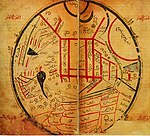

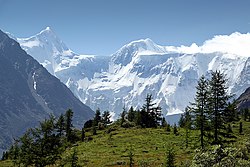



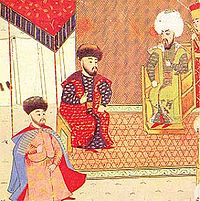
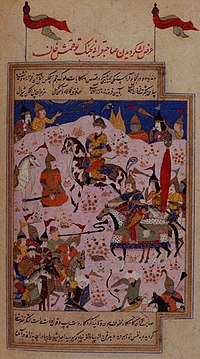


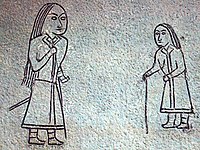
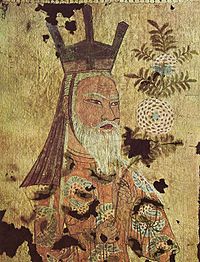
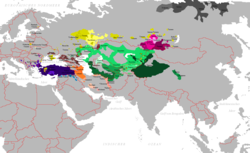




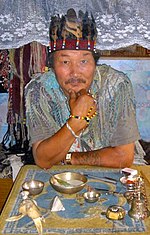

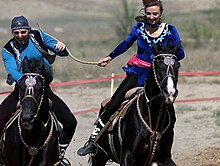

















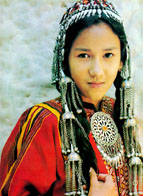



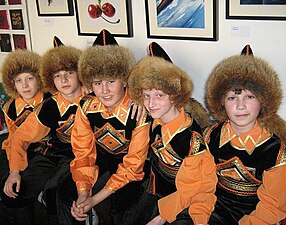

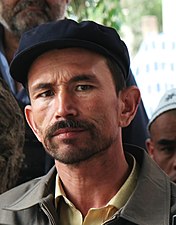
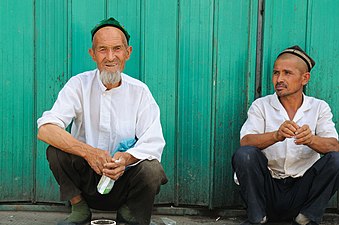
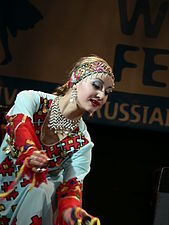



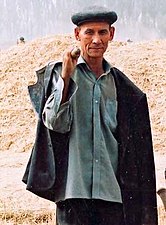

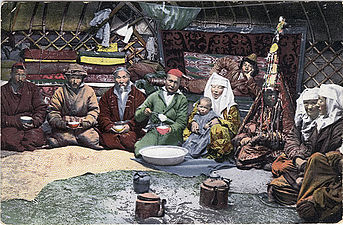

No comments:
Post a Comment